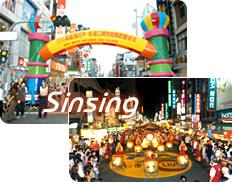
Sinsing District used to be called Dagangpu. In early Taiwan, rivers and creeks that could be ferried across were generally called “Gang” and the wasteland was named “Pu”.Sinsing District was the endless wilderness before.There was a tributary of KaohsiungRiver flowing through the north border of the wilderness and abounding with dai fish. Therefore, the fishing port was called “Dai Gang” and people renamed it “Dagang” in accordance with assonance (in sounds of southern part of FukienProvince).Sinsing District located in the uncultivated plains by the riverside, thus was to be named Dagangpu. It is said that dai fish are carps.
During Takau era, residents in Dagangpu made a living by engaging in farming and lived simply. Although developing slowly, it should deploy water conservancy first before developing agriculture. Therefore, there were irrigation ditches spreading all over the Dagangpu since the year of Dao Kuag. Fields where ditches flowed through all became fertile lands growing the rice, sweet potato, sugarcane or maize. Thus people gathered to build villages. It was called “Feng Yi Jiang Nan” because products abound and the people live in plenty. Dagangpu developed gradually from the center of Zhu Wei to expand around. Besides building Gu Shou Pavilion as the tutelary god for villages, villages of Xia Zhu Wei, Ying Hou and Guo Gang Zai were also constructed.
After “Kaohsiung Post” was moved to Dagang in 1941, Dagangpu became an ever-bright city consisting of many tall buildings and evasive neon lights with unprecedented speed. In addition, establishment of the area from Railway Station to circle “Jhao He Tong” (Today’s Jhongshan 1st Road) also quickly furthered prosperity of Dagangpu. Before retrocession, only Jhongshan 1st Road was paved with asphalt in this district and others were narrow winding trails as well as paths on farmland. After government's efforts for many years, the density of the road network has been the first of the whole city at present.
After retrocession, Dagangpu bloomed gradually and was full of vitality. Thus it was named “Sinsing District”. “Sinsing” means prosperity in Chinese pronunciation. It is the lively and beautiful modernized administrative area at present. There are broad roads and streets, beautiful flowers and high buildings placed closely side by side, which makes a good impression on the visitors first to Sinsing District.